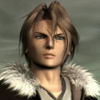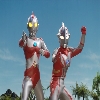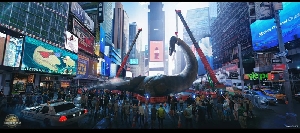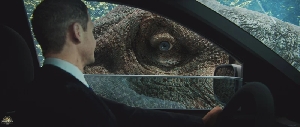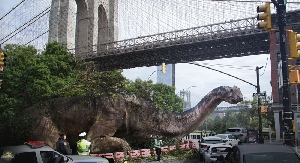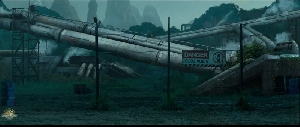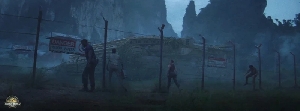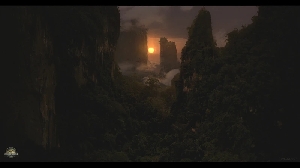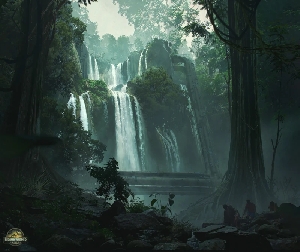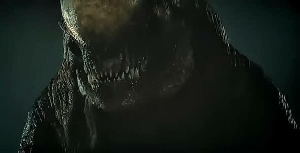Life: A 540 Million Year Journey Parts 10-11
Dinosaurs Forum Topic
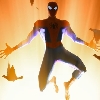
I Meme Everything
MemberAllosaurusNov 7, 20188091 Views2 RepliesPart 10: Late Cretaceous, 94 MYA
Ninety-four million years ago, Egypt is a very different place. This particular location is the Bahariya Depression. Instead of a vast desert, there is a complex river system that forms swampy wetlands. There are no Egyptians; it’s a primeval swamp. And, of course, it’s dominated by dinosaurs.
A herd of long-necked sauropods has come to a stream to drink and feed. These aren’t Barosaurus; they’re Paralititan, a titanosaur. The titanosaurs are the last group of sauropods in the world. Although none will grow as large as Barosaurus lentus, they are still lumbering giants. The herd is weary, for the swamps hold many predators. The apex of these is Carcharodontosaurus saharicus; a beast that can grow to lengths of forty-one feet and weigh seven tons. This male is named Horus. He’s the Cretaceous equivalent of a Lion, being an African apex predator. However, his teeth are more like those of a shark. In fact, the name Carcharodontosaurus means shark-toothed lizard.
Although he’s ate recently and is only here to drink, the sauropods keep their distance. The young stay close to their parents. Horus quenches his thirst. However, these streams are ruled by another carnivore--one larger and far more bizarre. Horus senses another predator in the area and lets out a low growl. He senses that it’s behind him, hissing back. He turns around to face the other theropod.
This is Spinosaurus aegyptiacus, Africa’s largest theropod. This individual is a male named Sobek. Although he’s ten feet longer than Horus and outweighs him by a ton, he has no interest in fighting. He does not hunt other dinosaurs; he specializes in spearing fish. He’s a piscivore. The end of Sobek’s snout, the premaxilla, have a peculiar shape. Although it’s strange, it’s useful for snagging fish. His arms, which are long for a theropod, end in sharp claws that act as fish-hooks. Only one species of theropod will be larger than this crocodilian duck, but it won’t evolve for another twenty-four million years.
Sobek stands slightly erect. His center of gravity is in his hips, and his long snout, neck, and arms are counterbalanced by a long, heavy tail. His vertebrae form a sail as tall as a man that curves downward in the middle. A thick layer of fat shows that he’s adapted for life in the waters. Spinosaurus evolved from a strange group of theropods that split off from Megalosauroidea. His ancestors took to the waters and settled for a piscivorous lifestyle. Spinosaurus is the last and largest of these specialists.
Sobek looks at the Paralititan herd as he steps into the water. These rivers are a bounty for him; they're full of fish, some of which can grow as long as cars. Sobek heads deeper into the water until it's up to his knees. He watches and waits as fish head downstream to his location. When one gets close enough, he throws his neck forward and snags it in his jaws. His premaxilla and conical teeth prevent the fish from slipping out as he steps back towards shore and tosses it down. Pinning it down with his foot, he slices it open with his claws and eats it.
As brutal as it is, Sobek is doing this simply to survive. And with such plentiful prey, he can leave waste. This benefits another predator: Rugops primus. He's a scavenger; his jaw lacks the power to take down prey. Rugops lives off the scraps of Spinosaurus. He watches Sobek re-enter the river before approaching the fish carcass and tearing out a piece of meat.
This time, Sobek dips his snout in the water with his mouth open. Nostrils set high on his skull allow him to keep breathing. His rostrum contains small holes, similar to what crocodiles have. The holes contain whiskers. These serve as sensors that pick up movement from prey. Sobek can tell where his prey is, which makes it easier to catch it. He grabs another one, shaking it in his jaws. He heads to the shore and drops it, pulling out a piece of meat. The Rugops, weary of the larger theropod, leaves, having filled his stomach.
*A month later*
It's breeding season for the Paralititan herd. The females use their feet to dig holes in the ground. To lay the eggs, they lower their bodies into a squatting position and drop them into the nest. Then, they cover the eggs with dirt, soil, and twigs. The herd slowly leaves; it will be months before they hatch.
However, the young are still vulnerable to predation. The Rugops from before, named Tut, walks over to a nest. He scrapes his toe claws on the ground, moving aside dirt and dust. He steps back and grabs one of the eggs. Tut walks off with it in his jaws.
Somewhere else, Horus is walking. He approaches his mate and their young. Horus carries the corpse of a juvenile Paralititan in his jaws before dropping it before them. He, his mate, and the juvenile rip into it with their serrated teeth.
*7 months later*
The eggs are ready to hatch. One hatchling pokes his little head out of the soil. He lets out a gentle call as he looks at his surroundings. It’s the dry season. The rivers have run dry and the sun beats down on the Egyptian landscape, which has turned into a dry desert. The baby digs himself out of the ground and chirps. The ground shakes as the herd returns to the nesting ground. The adults lower their long necks to make eye contact with the babies. Although it's a joyous moment, the herd can't find food to sustain their massive bulk.
The Carcharodontosaurus are also in desperate need of food. Horus’ mate died from starvation, so he raises their lone offspring. The two watch the herd. Horus knows it's suicide to attack a herd of fifty-ton adults. The juveniles are at the center of the herd and it's too risky to try to attack one. With no available food, survival trumps the paternal instinct. Horus grabs his young by the throat, killing him instantly. But the smell of blood is a lure to another carnivore.
Sobek has come looking for food. With the rivers gone, he's lost his principal source of prey. He growls at the Carcharodontosaurus. Horus snarls back. The two theropods snarl as they circle each-other. Horus lunges forward, biting Sobek's sail. The Spinosaurus winces in pain as he struggles to free himself. Horus lets go and grabs him by the neck. He forces Sobek to the ground as he raises his arm, slashing at his neck. Horus tightens his grip as Sobek keeps slashing. Sobek's thin neck breaks--and his body goes limp. Horus limps away but soon collapses; Sobek managed to sever his jugular vein.
***
The Spinosaurs and Carcharodontosaurs would fall into extinction. With them gone, a new group of theropod dinosaurs was rising to dominance: the Tyrannosaurs. They'd quickly take over the role of apex predator and grow larger with no rivaling carnivores. The Tyrannosaurs will culminate in the largest terrestrial predator of all time…
Part 11: Late Cretaceous, 66 MYA
It's the end of the Cretaceous Period, and by extension, the end of the Mesozoic Era. The continents vaguely resemble their modern forms, but this movement of the Earth's crust has caused an increase in volcanic activity. This has sparked massive eruptions that last for thousands of years, polluting the atmosphere with toxic gases. However, the dinosaurs have pulled through - for a little while longer.
After 160 million years, the scale and scope of the dinosaurs is awe-inspiring. A herd of Edmontosaurus annectens is grazing on plants. These giants are forty feet long and weigh four tons. They're one of the largest species of the hadrosaurs, one of the most successful groups of dinosaurs. They're quite common here in Montana of the United States.
But by far the most common dinosaur in this region is Triceratops prorsus, the largest and most famous of the horned dinosaurs. They're twice as common as Edmontosaurus here. Like the hadrosaurs, they live in herds for protection. Unlike them, they have natural defenses that make them hunter's bane. Their frills are made of solid bone that forms a protective shield around their necks. Their brow horns are as long as broomsticks.
But they're not this heavily armed without a reason. They live with the dinosaurs’ largest and most infamous predator. It's the Tyrant King of the Dinosaurs: Tyrannosaurus rex. T.rex is massive. It's three times larger than its direct ancestor, weighing in at nine tons. It stretches forty feet from head to tail and towers over the Earth at a height of twelve feet. Its jaws can bite down with the force of six tons; enough to crush a car.
This is a male named Zeus. He's stalking the Edmontosaurus, hiding in the dense forestry. His eyesight is three times stronger than that of an eagle. Slowly, he moves towards the herd--accidentally snapping a branch under his foot. They see him and flee. It's now or never--Zeus charges after the Edmontosaurus, but he's not fast enough to catch them. Although his bite force is higher than the mass of an adult Edmontosaurus, Zeus can't kill what he can't catch.
He chooses not to follow the herd. Zeus walks away, ignoring a herd of Triceratops. A single Trike would give him one hell of a fight; it's suicide to attack a herd. Catching prey is a dangerous act. Even the largest and deadliest of predators fail more often than they succeed. But Zeus won't give up so easily. He raises his head and sniffs the air. His skull accommodates massive olfactory bulbs, gifting him with one of nature's most acute senses of smell. He can detect a carcass from miles away.
Zeus follows the scent. He sees an Edmontosaurus carcass--but to his disappointment, there's something eating it: Dakotaraptor steini. Dakotaraptor is one of the last Dromaeosaurids. This female, named Artemis, is eighteen feet long, weighs over four-hundred kilograms, and is equipped with sharp teeth and claws. Although impressive by our standards, a nine-ton T.rex scoffs at the plunderer of Dakota. Artemis would be crazy to take on a Tyrannosaurus, especially on her own; she follows her instinct and flees.
Although T.rex is an active hunter, no self-respecting carnivore would turn down a free meal. It's much less risky to eat carrion than to bring down prey. In fact, the former has no risks for Zeus. He may have failed his earlier hunt, but he has no problem stealing another dinosaur's meal.
After eating, Zeus approaches a lake for a drink. He's weary of Borealosuchus. Like T.rex, Borealosuchus is an archosaur, but while Tyrannosaurus is more closely related to birds, Borealosuchus is a crocodilian, making her closer to modern alligators and crocodiles. Zeus lets out a cooing sound before leaving. As he departs, Zeus stops and listens to a sound he detects using his inner ears. It's an infrasonic sound, undoubtedly a dinosaur. Only one animal in Montana can make such a sound: another T.rex.
Zeus releases his own infrasonic rumbles, telling the other T.rex that he's nearby. The pitch of the other Tyrannosaur's rumbles tell Zeus that it's a female Tyrannosaurus. Carrying the Edmontosaurus in his jaws, he approaches cautiously as the female comes into view. This is Hera. Female T.rex are more aggressive than males. While some males stay with their brothers as adults, females are almost always alone, except when they have a mate.
It's a good thing Zeus brought the carcass with him; he needs to court Hera with food to prevent her from attacking him. Zeus himself is full, so Hera finishes what's left of it. Tyrannosaurus are sexually dimorphic. Males have bright red above their eyes and on their hornlets, almost like a crown. Females don't have these bright colors, and their hornlets are also smaller.
The Triceratops are also in their mating season. Females are passive and gentle, but they're very picky about their mates. They tend to prefer males with larger horns and frills. Sometimes, two males will both try to mate with the same female. When this happens, they flush blood into their red frills, forming yellow spots. The best and brightest frill display usually intimidates the other male.
But sometimes, showing off isn't enough. The brow horns of Triceratops are dangerous, especially on two angry males. They square up and lock horns, engaging in a joust. A young buck is jousting with an old bull. They push each-other back and forth, ramming with their heads. The buck hits the bull with his head, cutting his frill. The bull runs off, crying out in pain as the buck approaches the female.
***
The two Tyrannosaurs spend the next few days together. They get to know each other and strengthen their bond. On one night, Zeus is out hunting. He sees a lone Triceratops. This is the buck who lost the joust. He's been humiliated, spending the past few days alone. Zeus watches him silently before charging. The bull barely turns around in time to see Zeus’ open jaws.
Zeus clamps down on the bull's horn with his powerful jaws. The Trike snorts as his horn is grabbed in a vice-like grip. Zeus uses his powerful muscles to shake his head. His skull is designed to withstand the pressure of struggling prey. The bull frees himself with a snap; his right brow horn is broken off. He turns around to face the predator.
The two animals size each other up. The Triceratops is three tons heavier than the Tyrannosaurus. Zeus knows the risks of fighting one. His instincts are razor-sharp as he looks the Trike in the eyes. The bull manages to land a grazing blow to the thigh of the T.rex, causing Zeus to hiss in pain. The Trike swings his head into Zeus’ face, knocking out a few teeth. The Tyrannosaur shakes his head profusely before the Trike knocks him over, breaking three ribs. The bull lowers his head, preparing to end Zeus but something grabs his tail--Hera! This allows Zeus to recover and land the killing blow.
Zeus lets out a low growl. Hera approaches as Zeus steps back. She begins to gorge, ripping out pieces of flesh and throwing her head back. Zeus waits cautiously before eating his fill. The two share the carcass and nuzzle. They've cemented their bond. That same night, they mate. T.rex are famous for their small arms. Despite their puny appearance, they could lift over four hundred pounds of weight. Zeus uses his arms to hold onto Hera while mating.
***
The next morning, Hera is digging a hole in the ground using her massive toe claws. She hinges her legs next to her body as she lays eight eggs in the hole. Then, she and Zeus pile sticks and dirt on top of it. They've built their nest. Hera won't leave it until the eggs hatch. This makes it Zeus’ job to hunt for the family.
One day, while the two T.rex are resting, Artemis stalks the nest. She silently approaches, digging it open with her sickle claws. Contrary to popular belief, they're not used to disembowel prey; they help pin prey down. Artemis takes one of the eggs and leaves.
When the two Tyrannosaurus awaken, they see that there's an opening in the nest. One of the eggs is gone. Hera snorts and fills in the hole with dirt and mud. She won't let any thieves take the remaining eggs. The two aren't hungry right now, so they spend most of their time guarding the nest or resting. The two alternate between guarding the nest. While one guards the eggs, the other gets some much-needed rest.
Watching the two is a little mammal called Didelphodon. She stands no chance against a dinosaur. She'll have to wait for her chance. The mammal leaves, but she'll be back.
Under the cover of darkness, she seizes her chance. The two theropods are resting, so she quietly hops on the nest. The Didelphodon uses her paws to dig. She sees the seven remaining eggs. Each one is comparable in size to her, so she has to climb inside the nest and push one out. She does this, and one of the eggs tumbles onto the ground. Pushing it with her head, she attempts to break open the coconut-sized egg.
When she succeeds, she sees that the embryo is already dead. The toxic chemicals in the atmosphere are preventing some dinosaur eggshells from forming properly. This doesn’t bother her, and she eats it anyway. The Tyrannosaur eggs aren’t the only ones suffering; all other dinosaurs are struggling to bring new young into the world because of the pollutants the volcanoes have released into the atmosphere.
Also eyeing the nest is one of Montana’s most obscure inhabitants: Anzu wyliei. He’s a cousin of Oviraptor from Asia. He’s an omnivore, able to eat both meat and plants for sustenance. Tonight, he has his sights set on the T.rex nest. Because of his larger size, it’s easier for him to dig out the eggs. He takes one and carries it in his mouth, and uses his arms to carry another. Suddenly, something grabs his thin neck and breaks it instantly--Zeus was alerted to his presence. However, the egg falls out of the mouth of the Anzu and shatters. Hera wakes up from the commotion, and sees that only five of the eight eggs are left.
*2 months later*
The two Tyrannosaurus are able to hear the sound of eggshells cracking. They quickly use their massive heads to move aside dirt and mud. Four of the five hatch; the one egg that didn’t hatch has succumbed to the toxic atmosphere. The hatchlings imprint on their nine-ton parents. They may have hatched, but their survival isn’t set in stone. Luckily, their parents are fiercely protective of them. The babies will stay in the nest under Hera’s watchful eyes while Zeus procures food for the family.
*2 years later*
The four babies have hit their first growth spurt. They’re ten feet long, and they’re already showing signs of an apex predator. They chase small lizards and Didelphodon around, but Hera never lets them stray too far. She knows it’s a dangerous world and will do everything she can to keep her young safe. Even the herbivores are out to get the chicks because they know that they’ll grow into forty-foot beasts that will terrorize them. It’s understandable.
One such herbivore is Ankylosaurus magniventris: a big thyreophoran with a little brain. Much to Hera’s displeasure, he gets between her and her young. The mother snarls at the Ankylosaur. Under normal circumstances, a Tyrannosaurus wouldn’t face such an armored herbivore, but she won’t leave her offspring. She makes a mock lunge, but gets too close for the plant-eater’s comfort. Acting on pure instinct, he swings his tail, smashing his club into her leg. Hera groans in pain before collapsing as the herbivore walks off. One of the chicks gets too close to him; he gets flattened by the irritable vegetarian. The remaining three run off in fear.
At night, Zeus returns, carrying a carcass. But everything’s wrong. Hera’s down; her leg’s broken. Their young are nowhere in sight. The three chicks are frolicking, unsure of what to do. But in the darkness of night, they’re vulnerable. A hunter is watching them. She bears her arm claws, tapping her sickle-claws on the ground. She tenses her muscles before leaping forward, tackling one of the little Tyrannosaurs to the ground. The other two flee the scene as Artemis feasts on their brother. They sense that something is coming. Something big.
It’s Zeus! He nudges the chicks and leads them back towards Hera. They’re now aware of the dangers of straying from Mom and Dad. The two remaining siblings, one male, the other female, are named Ares and Athena.
*10 years later*
Ares and Athena are teenagers. They’re ready for their first hunt. Ares is stalking a herd of Edmontosaurus. He’s looking for a sick, injured, or old animal. The T.rex scans the herd, analyzing each and every individual. The teen locks onto his target: an old female. Although he and Athena lack the raw power to dispatch one of the four-ton herbivores, he has another weapon on his side: speed. Juvenile Tyrannosaurus have longer legs than the adults, and are faster. Both juveniles and adults play critical roles in the hunt.
He springs forward, causing the herd to panic as they begin to flee. Ares chases the old female, attempting to separate her from the herd. Athena is lying in wait. When she sees Ares and the quarry coming, she springs out of the forest and the two siblings chase her. The Edmontosaurus suddenly sees two adults approach--Hera and Zeus. Zeus clamps down on the neck of the old hadrosaur with a force strong enough to cause bones to essentially explode. The family of four begins to consume the carcass.
Tyrannosaurus rex has terrorized its kingdom for the last time. An asteroid six miles wide slams into what is now the Yucatan Peninsula, gouging out a crater over a hundred miles wide. Plants and animals are vaporized in seconds as a storm of fire and ash rushes towards North America. The dinosaurs see what can only be described as a cloud of fire rushing towards them. Artemis takes cover in a cave. The Tyrannosaurs abandon their kill and frantically look for shelter.
Hadrosaurs and ceratopsians are burned alive as flames consume the vegetation. A cloud of dust and debris settles in the atmosphere as acidic rain begins to fall out of the darkening sky. The sun won’t shine again for months. Shockingly, many dinosaurs survive the initial impact, but they’re living on a time bomb.
Herbivores have no food. Most of Montana’s vegetation has either been burned by the fires and acid rain or wilted in the darkness. With nothing to eat, their bodies litter the gray landscape. Within six months, Edmontosaurus, Ankylosaurus, and Triceratops are extinct. The predators are a bit more fortunate because they can eat the herbivores. The bodies of the extinct herbivores litter the landscape. But the carnivores won’t last much longer without a sufficient source of food.
Eight months after impact, the last carcass of Triceratops has been stripped by Artemis. There’s nothing left but bones. Suddenly, something grabs her; it’s Zeus. His family has succumbed to starvation. He’s the world’s last Tyrannosaurus rex, and by extension, Earth’s last non-avian dinosaur. He quickly devous Artemis’ body, but there’s nothing else for him to eat. Within a week, he collapses, panting. He’ll never get up again. The starving giant looks around at the world one last time before passing away.
However, not all the dinosaurs are dead. Birds will make it through the extinction, as will crocodilians. These archosaurs will continue to evolve. But it is the mammals whose time has come. With the Mesozoic’s end, the Cenozoic Era dawns.
"Part of the journey is the end..."
Replies to Life: A 540 Million Year Journey Parts 10-11
Hey Guest, want to add your say?
Are you an avid Jurassic World fan looking for a dedicated online community of likeminded fans? Look no further! Create your own profile today and take part in our forums and gain XP points for all the content you post!

